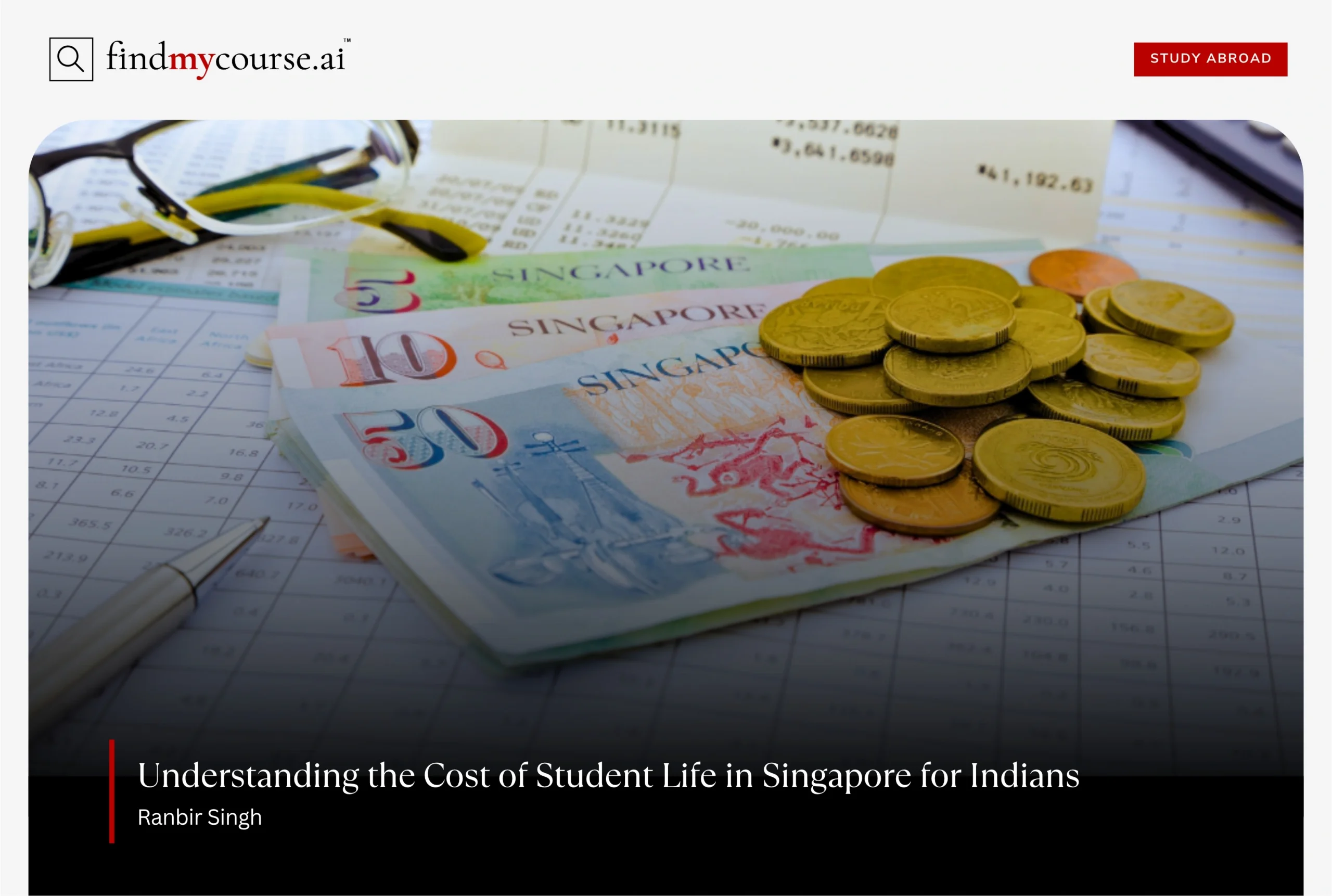Planning to study abroad in Singapore? You’re not alone—Many Indian students choose this dynamic city for its world-class universities, safe environment, and international culture. But before you make the move, it’s essential to understand the cost of living in Singapore. This guide breaks it down clearly and practically, so you can focus on your education without worrying about unexpected expenses. Whether you plan to study in Singapore for a semester or several years, budgeting smartly will make your student life much smoother.
Understanding the Cost of Living in Singapore
Before we break down the details, it’s helpful to understand what living in Singapore generally costs for a student. Your monthly spending will depend on where you live, how you manage daily expenses, and the kind of lifestyle you prefer. While some students keep things simple and stick to a tight budget, others may choose more comfort and flexibility at a higher cost. To help you plan effectively, let’s take a closer look at the key areas that shape the cost of living in Singapore.
Accommodation Options
Housing is one of the most significant expenses you’ll face while living in Singapore. Your monthly rent will vary depending on where and how you choose to live.
| Accommodation Type | Estimated Monthly Cost (SGD) |
| On-campus dorm (shared) | 325 – 600 |
| Private student hostel | 600 – 1,500 |
| Shared HDB or apartment room | 700 – 2,000 |
On-campus dormitories are the most budget-friendly and also offer a great way to meet fellow students. However, spaces are limited, so applying early is crucial. If you prefer more independence, renting a room in a shared flat is a popular option. Woodlands and Jurong generally offer more affordable housing than central parts of Singapore.
Managing Your Daily Costs – Food and Groceries
Singapore has a lively food scene, with options ranging from expensive restaurants to cheap hawker centres.
- Hawker meals: SGD 3–7 per meal
- Groceries: SGD 250–400 per month
- University canteen/meal plans: SGD 90–120 monthly
Eating out at local food courts often cost less than cooking at home, especially when you’re short on time. However, grocery shopping and occasional cooking still help balance your diet and budget. Consider joining loyalty programs at supermarkets like FairPrice or Giant for savings.
Budgeting for Transport in Singapore
Getting around Singapore is efficient, safe, and affordable—especially for students.
- Student MRT/bus concession pass: SGD 45–55/month (capped)
- Single public transport trip: SGD 1.50–2.00
- Taxi/ride-hailing (occasional): SGD 10–30 per trip
With a reliable public transport system covering the entire city-state, you’ll rarely need a car. Moreover, student concession passes can save you significantly over time.
Monthly Utility and Internet Expenses
Private rentals usually exclude utilities and internet, so remember to add them to your monthly budget.
- Utilities (electricity, water, gas): SGD 100–150
- Wi-Fi/internet: SGD 40–60
- Mobile data plan: SGD 20–30
If you’re sharing an apartment, these costs will be divided among roommates. Singapore’s utility rates depend on usage, so using air conditioning wisely—especially in the hot season—can help lower your bills.
Educational and Health-Related Costs
Tuition costs vary by institution and program, but you should also budget for academic and healthcare expenses.
- Annual tuition (public universities): SGD 16,000–40,000
- Private institutions: May range higher, depending on the program
- Student health insurance: SGD 900–5,000 annually
Many universities offer basic health coverage, but private insurance plans can offer broader protection. Be sure to check what’s included in your student package before arriving.
Personal Expenses and Leisure Activities
Living in Singapore doesn’t mean you have to miss out on fun! Although Singapore has a high cost of living, you can still find plenty of affordable or free ways to enjoy your time.
| Category | Average Monthly Spend (SGD) |
| Entertainment | 50–150 |
| Gym, hobbies, etc. | 40–100 |
| Shopping & personal spending | 100–200 |
Exploring local parks, free museum days, and university-hosted events are great ways to unwind without spending a fortune. Additionally, student discounts are widely accepted at cinemas, museums, and even cafes.
Monthly Cost of Living for Indian Students in Popular Areas of Singapore
| Expense Category | Queenstown (Student-Friendly Hub) | Orchard (Upscale City Living) | Bukit Timah (Academic & Green District) | Tiong Bahru (Trendy & Cultural Area) | Dover (Campus-Close Budget Zone) |
| Accommodation (Shared) | 900 – 1,300 SGD | 1,400 – 2,000 SGD | 1,200 – 1,800 SGD | 1,100 – 1,600 SGD | 850 – 1,300 SGD |
| Food & Groceries | 300 – 400 SGD | 350 – 500 SGD | 350 – 450 SGD | 300 – 450 SGD | 280 – 400 SGD |
| Public Transport (Pass) | 45 – 55 SGD | 45 – 55 SGD | 45 – 55 SGD | 45 – 55 SGD | 45 – 55 SGD |
| Utilities & Internet | 140 – 180 SGD | 150 – 200 SGD | 150 – 190 SGD | 140 – 180 SGD | 130 – 170 SGD |
| Mobile Plan | 20 – 30 SGD | 20 – 30 SGD | 20 – 30 SGD | 20 – 30 SGD | 20 – 30 SGD |
| Leisure & Personal | 100 – 200 SGD | 150 – 250 SGD | 130 – 220 SGD | 120 – 200 SGD | 100 – 180 SGD |
| Miscellaneous | 50 – 100 SGD | 70 – 120 SGD | 60 – 100 SGD | 60 – 100 SGD | 50 – 90 SGD |
| Total Monthly Estimate | 1,555 – 2,265 SGD | 2,185 – 3,155 SGD | 2,005 – 2,945 SGD | 1,785 – 2,665 SGD | 1,475 – 2,225 SGD |
Key Notes:
- Queenstown and Dover are popular with students at NUS and other west-side institutions. They offer relatively affordable housing with good MRT access.
- Orchard is central and upscale, with higher accommodation and leisure costs.
- Bukit Timah is green and prestigious, close to several universities but with mid-to-high living expenses.
- Tiong Bahru offers a trendy, cultural vibe, ideal for students who enjoy a balance of city life and heritage charm.
Smart Tips to Save on Living Costs
Even though the cost of living in Singapore is high compared to many other Asian countries, it’s still possible to live affordably with the right approach:
- Apply for student concession cards to reduce public transport costs
- Take advantage of campus facilities for meals and recreation
- Shop at budget-friendly outlets and local markets
- Share accommodation with other students
- Attend free university events and social clubs
- Use cashless apps for meal deals and transportation rebates
FAQs
1. How much money does a student need to live in Singapore each month?
Most students spend between SGD 1,200 and SGD 2,500 monthly, depending on lifestyle and housing choices.
2. What’s the cheapest housing option in Singapore for students?
On-campus dormitories are usually the most affordable, starting at around SGD 325 per month.
3. Are there student discounts for public transport in Singapore?
Yes, international students can get discounted MRT and bus fares with a student concession card.
4. Is food expensive in Singapore?
Eating out at hawker centres is budget-friendly, with meals costing around SGD 3–7.
5. What are the hidden costs Indian students should plan for?
Initial one-time expenses such as housing deposits, insurance, and household essentials can range from SGD 3,000 to 5,000.
Conclusion
The cost of living in Singapore for Indian students may appear high at first, but with careful budgeting and mindful spending, it’s entirely manageable. By planning ahead and exploring your options, your student life can be both enriching and financially stable. Whether you’re inspired by Singapore’s academic excellence or its vibrant lifestyle, thoughtful preparation can make studying here a smart and fulfilling choice.


